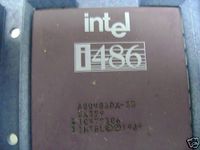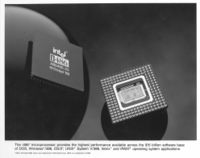Difference between revisions of "Intel 80486"
m (Proper Intel jargon for FPU) |
(Move content in from dup page) |
||
| (One intermediate revision by the same user not shown) | |||
| Line 1: | Line 1: | ||
| − | + | [[Image:80486DX-33 CPU.jpg|200px|thumb|left|An 80486 cpu]] | |
| − | + | The '''Intel 80486''' is the successor to the [[Intel 80386]] in the [[Intel x86]] line of [[microprocessor]]s, the 4th generation in that line. It is basically the same [[Central Processing Unit|CPU]] as the 386, but includes an 8K byte [[cache]], and optionally (in the 80486DX model) the functionality of the [[Intel 80387]] numeric [[co-processor]], the [[floating point]] unit. | |
| − | + | Implementation changes mean about half the [[instruction]]s execute in one [[clock]] cycle, instead of the two used in the 386, speeding it up considerably. Its [[main memory]] [[data bus]] is 32 [[bit]]s wide, the same as the 386.` | |
| − | + | [[Image:i486 promo poster.jpg|200px|right|thumb|A 486 promo poster]] | |
| − | {{stub}} | + | Later cost cutting variations included the 486SX, which was die compatible with the original 486DX part, except it had its math co-processor disabled. For the 486SX model, the 80487SX numeric co-processor is available. The 487SX part was in fact a 486DX CPU, and when it was installed, it turned off the 486SX, and did all the work. |
| + | |||
| + | The 486DX was offered in 25, 33, 50 and 66 MHz versions; a 100 MHz version was demonstrated in 1990. For the 486SX, the speeds were 16, 20, 25 and 33 MHz. | ||
| + | |||
| + | The 486's replacement was the [[Intel Pentium]]. | ||
| + | |||
| + | ==External links== | ||
| + | |||
| + | * [http://www.pcguide.com/ref/cpu/fam/g4I486SX-c.html Intel 80486SX] | ||
| + | |||
| + | {{semi-stub}} | ||
| + | |||
| + | [[Category: Intel Microprocessors]] | ||
Latest revision as of 11:26, 3 November 2018
The Intel 80486 is the successor to the Intel 80386 in the Intel x86 line of microprocessors, the 4th generation in that line. It is basically the same CPU as the 386, but includes an 8K byte cache, and optionally (in the 80486DX model) the functionality of the Intel 80387 numeric co-processor, the floating point unit.
Implementation changes mean about half the instructions execute in one clock cycle, instead of the two used in the 386, speeding it up considerably. Its main memory data bus is 32 bits wide, the same as the 386.`
Later cost cutting variations included the 486SX, which was die compatible with the original 486DX part, except it had its math co-processor disabled. For the 486SX model, the 80487SX numeric co-processor is available. The 487SX part was in fact a 486DX CPU, and when it was installed, it turned off the 486SX, and did all the work.
The 486DX was offered in 25, 33, 50 and 66 MHz versions; a 100 MHz version was demonstrated in 1990. For the 486SX, the speeds were 16, 20, 25 and 33 MHz.
The 486's replacement was the Intel Pentium.

